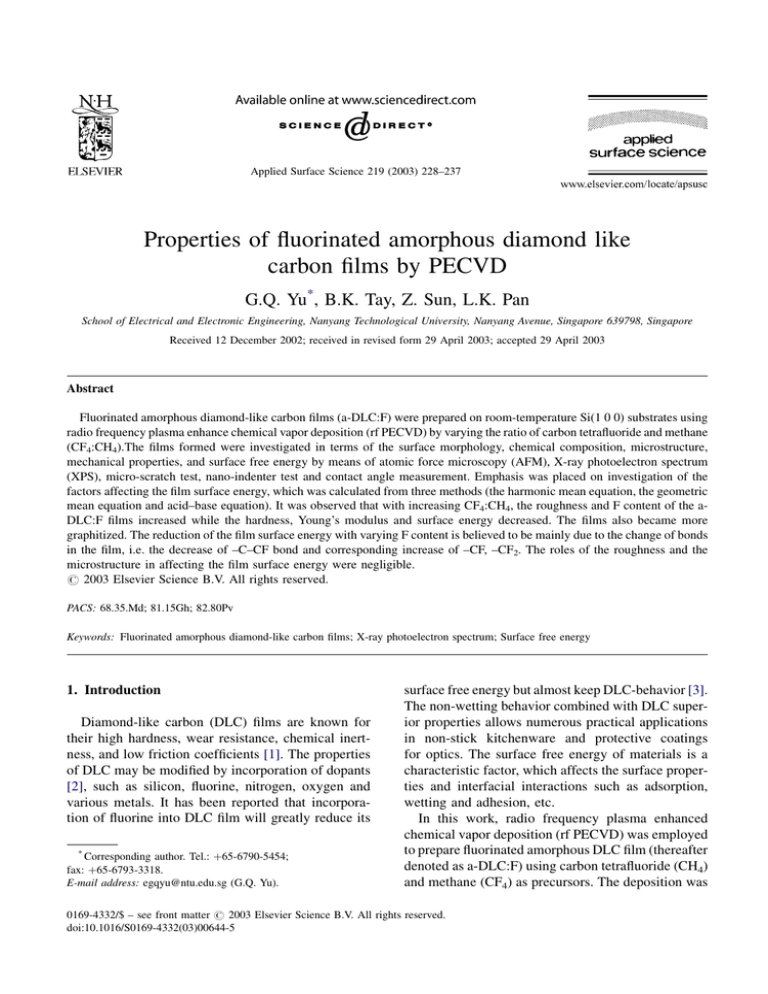
Applied Surface Science 219 (2003) 228–237
Properties of fluorinated amorphous diamond like
carbon films by PECVD
G.Q. Yu*, B.K. Tay, Z. Sun, L.K. Pan
School of Electrical and Electronic Engineering, Nanyang Technological University, Nanyang Avenue, Singapore 639798, Singapore
Received 12 December 2002; received in revised form 29 April 2003; accepted 29 April 2003
Abstract
Fluorinated amorphous diamond-like carbon films (a-DLC:F) were prepared on room-temperature Si(1 0 0) substrates using
radio frequency plasma enhance chemical vapor deposition (rf PECVD) by varying the ratio of carbon tetrafluoride and methane
(CF4:CH4).The films formed were investigated in terms of the surface morphology, chemical composition, microstructure,
mechanical properties, and surface free energy by means of atomic force microscopy (AFM), X-ray photoelectron spectrum
(XPS), micro-scratch test, nano-indenter test and contact angle measurement. Emphasis was placed on investigation of the
factors affecting the film surface energy, which was calculated from three methods (the harmonic mean equation, the geometric
mean equation and acid–base equation). It was observed that with increasing CF4:CH4, the roughness and F content of the aDLC:F films increased while the hardness, Young’s modulus and surface energy decreased. The films also became more
graphitized. The reduction of the film surface energy with varying F content is believed to be mainly due to the change of bonds
in the film, i.e. the decrease of –C–CF bond and corresponding increase of –CF, –CF2. The roles of the roughness and the
microstructure in affecting the film surface energy were negligible.
# 2003 Elsevier Science B.V. All rights reserved.
PACS: 68.35.Md; 81.15Gh; 82.80Pv
Keywords: Fluorinated amorphous diamond-like carbon films; X-ray photoelectron spectrum; Surface free energy
1. Introduction
Diamond-like carbon (DLC) films are known for
their high hardness, wear resistance, chemical inertness, and low friction coefficients [1]. The properties
of DLC may be modified by incorporation of dopants
[2], such as silicon, fluorine, nitrogen, oxygen and
various metals. It has been reported that incorporation of fluorine into DLC film will greatly reduce its
*
Corresponding author. Tel.: þ65-6790-5454;
fax: þ65-6793-3318.
E-mail address: egqyu@ntu.edu.sg (G.Q. Yu).
surface free energy but almost keep DLC-behavior [3].
The non-wetting behavior combined with DLC superior properties allows numerous practical applications
in non-stick kitchenware and protective coatings
for optics. The surface free energy of materials is a
characteristic factor, which affects the surface properties and interfacial interactions such as adsorption,
wetting and adhesion, etc.
In this work, radio frequency plasma enhanced
chemical vapor deposition (rf PECVD) was employed
to prepare fluorinated amorphous DLC film (thereafter
denoted as a-DLC:F) using carbon tetrafluoride (CH4)
and methane (CF4) as precursors. The deposition was
0169-4332/$ – see front matter # 2003 Elsevier Science B.V. All rights reserved.
doi:10.1016/S0169-4332(03)00644-5
G.Q. Yu et al. / Applied Surface Science 219 (2003) 228–237
229
performed as a function of CF4:CH4 ratio at rf power
of 60 W. The films properties were investigated by
means of contact angle measurement, atomic force
microscopy (AFM), X-ray photoelectron spectroscopy (XPS), Raman spectroscopy, scratch test and
nano-indenter. The emphasis studied was focused
to investigate the factors affecting the film surface
energy.
2. Experimental details
2.1. Film preparation
Fig. 1. Schematic diagram of our experimental setup.
The experimental setup, capacitively coupled radio
frequency (13.56 MHz) plasma enhanced chemical
vapor deposition (rf PECVD) was schematically given
in Fig. 1, where its configuration is asymmetrical. As
such, self-bias will be produced on substrate during the
deposition. This self-bias originates from the large
difference of motion speed between electrons and ions
in plasma [4], and depends on process parameters, such
as rf power applied, as shown in Fig. 2. After being
ultrasonically cleaned in acetone, methanol and deionized water in sequence, Si(1 0 0) substrates were
placed on the cathode electrode kept at room-tempera-
ture by cooling water. The base vacuum in the chamber
is 106 Torr. Before deposition, the substrates were in
situ sputter cleaned for 10 min in argon plasma operated
at 100 W. High-purity CH4 and CF4 were led into
chamber as gas precursors. Avery thin carbon interlayer
was first deposited to improve the overall adhesion, and
then a-DLC:F films were deposited at varying CF4:CH4
flow rate ratio (referred to as CF4:CH4) and 60 W
power. A DLC film deposited by the same setup was
used as a reference sample. During deposition, the
process pressure was fixed at 50 mTorr.
Fig. 2. Relationship between self-bias and rf power.
230
G.Q. Yu et al. / Applied Surface Science 219 (2003) 228–237
2.2. Surface energy calculation
2.3. Other characterizations
The surface free energy of the samples is generally
obtained from measuring contact angle formed when
liquid drops on the sample surface. The relationship
between surface energy of the sample (gS) and the
contact angle (y) is universally described by the Young
equation [5],
The surface morphology of the films was observed
over 1 mm 1 mm by a scanning atomic force microscope (AFM, Nanoscope IIIa) with a tapping mode.
The chemical composition and bonding states of the
films were characterized by X-ray photoelectron spectroscopy (XPS) with Al Ka line (1486.6 eV) as the
exciting source. In this characterization, the system
was calibrated by the binding energy (284.7 eV) of
C 1s and all samples were analyzed without surface
etching. A micro-Raman spectroscopy (Renishaw
1000) with 514.5 nm Arþ laser was used to study
the film microstructure, where the laser output power
used was 2 mW. The adhesion property was analyzed by micro-scratch test. Scratch test parameters
used were as follows: progressive type, a maximum
load of 25 N, loading rate of 4 N/min, the scratch
length of 5 mm Rockwell-type diamond indenter with
200 mm radius. The hardness (H) and Young’s modulus (E) were characterized by a nano-indenter (nanoindenter II, nano-instruments), where the continuous
stiffness option was used and the maximum load was
10 mN.
gS ¼ gL cos y þ gLS
where gL is the known surface energy of the testing
liquid, gLS the unknown interfacial energy of the film/
liquid. To eliminate gLS from the equation, many
methods have been developed based on consideration
of the intermolecular forces. Among all, three methods [6–8] are often used, namely the harmonic mean
equation (Eq. (1)), the geometric mean equation
(Eq. (2)) and acid–base equation (Eq. (3)). They are
expressed, respectively, as follows,
d d
gS gL gpS gpL
gLS ¼ gS þ gL 4 d d þ p p
(1)
gS gL gS gL
qffiffiffiffiffiffiffiffiffi qffiffiffiffiffiffiffiffiffi
gdS gdL þ gpS gpL
(2)
gLS ¼ gS þ gL 2
gLS
qffiffiffiffiffiffiffiffiffiffiffiffiffiffiffiffi qffiffiffiffiffiffiffiffiffiffi qffiffiffiffiffiffiffiffiffiffi
þ
LW
gþ
g
¼ gS þ gL 2
gLW
S gL þ
S gL
S gL þ
(3)
where g with superscript d and p means a dispersion
component and a polar component, g with superscript
LW, (þ) and () stands for a Lifshitz–van der Waals
component, Lewis acid component and Lewis base
component. Three liquids with different polarity,
de-ionized water, methylene iodide (CH2I2) and formamide, were applied for the measurement. The
contact angle was averaged over four data obtained
from different spots on the samples for each liquid.
Comparison on the surface energy calculated from the
above methods was also performed.
It should be pointed out that another surface energy,
critical surface energy (gc) is often mentioned elsewhere. This critical surface energy is introduced
by Zisman [9], and is the surface energy of a reference
liquid which fully wets the sample surface, i.e.
gc ¼ gL ¼ gS at y ¼ 90 . In this work, this value
was not given.
3. Results
3.1. Surface morphology
Fig. 3 gave a typical AFM image of the a-DLC:F
films. The films deposited were all uniform and
smooth. Compared with DLC reference sample
(0.17 nm), the a-DLC:F films exhibited more rougher
surface. The surface roughness also increased with
CF4:CH4, from 0.23 nm at 1:4–0.28 nm at 4:1, as
shown in Fig. 4. The increase was possibly caused
by fluorine preferential etching of the films since the
films were not ideally isotropic. In addition, the
variation of the roughness with the ratio seemed not
monotonous.
3.2. Chemical compositions and bonding states
Fig. 5 showed the C 1s local XPS spectrum for the
film deposited at 1:1. It was well decomposed into four
peaks, which centered at 284.9, 287.4, 289.8 and
292.3 eV, respectively. Due to surface contamination
G.Q. Yu et al. / Applied Surface Science 219 (2003) 228–237
231
Fig. 3. A typical AFM image of the film (1:1).
and charging effect during XPS analysis, it is very
complex and also still controversial to identify these
peaks. According to Touhara and Okino [10], the peak
at 285 eV was assigned to the carbon atoms with the
mixed bonded structures of sp2 and sp3 configurations,
and the peak at 287 eV was due to the carbon atoms
bonded to oxygen. In addition, the peaks with 289 and
291 eV were ascribed to CF bonds and CF2 bonds,
Fig. 4. The film roughness dependent of CF4:CH4.
232
G.Q. Yu et al. / Applied Surface Science 219 (2003) 228–237
Fig. 5. C 1s XPS spectrum of the film (1:1).
respectively. The peak at 292 eV was not reported.
In other references [11–14], assignment was made
between binding energy and structural unit as: –C–CH
(284.6 eV), –C–CF (287.4 eV), –CF (289.5 eV), –CF2
(292 eV), –CF3 (294 eV). Based on the above data
and the fact that a small amount of oxygen occurs on
the films surface and hydrogen always occurs in the
PECVD-deposited films as reflected in the Raman
spectrum below, assignment is done as follows:
–C–C and –C–CH (284.9 eV), –C–CF and –C¼O
(287.4 eV), –CF (289.8 eV) and –CF2 (292.3 eV),
where the fraction of –C–CH and –C¼O should be
much lower than that of –C–C and –C–CF, respectively. On the other hand, F atomic concentration can
be obtained by the following equation:
Ai =Si
atomic concentration ð%Þ ¼ P
i ðAi =Si Þ
where subscript is film element, A and S is the peak
area and sensitivity factor of the element (S ¼ 0:78,
1.00 for C 1s and F 1s [10]). Similarly, the bond
concentration was also done according to the relevant
peak area divided by the sum of all the peaks area.
Their concentrations were presented in Fig. 6, with
varying CF4:CH4. It was observed that F was incorporated into the films with addition of CF4, and then
increased correspondingly with CF4:CH4. At CF4:CH4
of 1:4, F incorporated existed primarily in the form
of CF bond state (–C–CF and –CF). The amount of
–C–CF was greater than that of –CF. As CF4:CH4
increased up to 4:1, the former content decreased
while the latter concentration increased relatively
slightly. What’s more, when CF4:CH4 increased to
1:1, another bonding state, C–F2 appeared in the films.
Afterwards, C–F2 content gradually increased with
increasing CF4:CH4.
3.3. Microstructure
The microstructure of the a-DLC:F film was very
similar to that of DLC (Fig. 7), where G-band
(‘‘graphite’’, 1540 cm1) and D-band (‘‘disorder’’,
1340 cm1) were obviously observed after fitting.
The G-band originates from the symmetric E2g vibrational mode in graphite-like materials, while the D-band
arises from the limitations in the graphite domain size
induced by grain boundaries or imperfections [15],
e.g. sp3 carbon, or other impurities. Quantitative analysis (Fig. 8) revealed that the intensity ratio of D- and
G-band (ID/IG) increased, and G-band shifted upward
with increasing CF4:CH4, which were due to an
increased number of sp2 bonds and the formation of
sp2 clusters in the amorphous network, i.e. rings or
chains [16]. This result indicated the films became
G.Q. Yu et al. / Applied Surface Science 219 (2003) 228–237
233
Fig. 6. Concentrations of F and bonds of films at different CF4:CH4.
more graphitic with the increase in F content. It was
also found that photoluminescence (PL) background
appeared in Raman spectra, and decreased with more
addition of CF4. The PL is generally believed to
originate from hydrogen (H) or be due to that film
is polymer-like as confirmed in carbon nitride film
[17–19]. In our case, the films deposited are diamondlike carbon as disclosed later. It is therefore concluded
the PL here is ascribed to H atoms in the films, where
some H atoms are replaced by F atoms due to F
incorporation and the PL intensity is reduced correspondingly. It should be here pointed out that, to some
Fig. 7. A typical Raman spectrum of a-DLC:F film (1:4).
234
G.Q. Yu et al. / Applied Surface Science 219 (2003) 228–237
Fig. 8. Dependence of ID/IG and G-band peak position on CF4:CH4.
extent, the role of F is similar to that of N in carbon
nitride film, where C–H content also decreases with
more incorporation of N, as evidenced by FTIR
analysis [19].
3.4. Mechanical properties
Scratch test disclosed the a-DLC:F films were
all well adhesive to the substrate (not shown). The
Fig. 9. Dependence of the film hardness and modulus on CF4:CH4.
G.Q. Yu et al. / Applied Surface Science 219 (2003) 228–237
hardness (H) and Young’s modulus (E) can be calculated from the indentation load-displacement data
[20]. It was drawn that the film hardness and modulus
both decreased with increasing CF4:CH4 (Fig. 9).
As shown, with the introduction of CF4 gas, the film
hardness and modulus slightly dropped compared
with that of DLC reference sample. When CF4:CH4
increased, they further decreased. The lowest hardness was 16 GPa larger than that of Si substrate
(12 GPa). This hardness feature of the films is
guaranteed by the above-mentioned self-bias produced on the substrate, which increases the bombarding energy of deposited species and therefore results in
the formation of DLC films [21]. The decrease in the
film hardness is believed to be partly due to change in
the microstructure as concluded from Raman analysis,
235
i.e. more graphitized with more incorporation of F into
the films. Another possible cause is the reduction in
the internal stress of the films induced by F incorporation into the films.
3.5. Surface free energy
Fig. 10 showed the variation of the film surface
energy with varying CF4:CH4. From (a), after introduction of CF4 at 1:4, the surface energy was sharply
reduced compared with that of DLC reference sample,
suggesting something like chemical composition
altered in the films. The reduction extent calculated
from the geometric mean method was more than those
from the other two. On the other hand, the reduction
rate did not vary until CF4:CH4 reached 1:2. After that,
Fig. 10. Surface energy of the films deposited at the different CF4:CH4.
236
G.Q. Yu et al. / Applied Surface Science 219 (2003) 228–237
the reduction rate increased. As CF4:CH4 c increased
to 2:1, the surface energy seemed to drop most
quickly. The change in the reduction rate was very
similar for all the methods. From (b) and (c), it was
also concluded that the reduction in the surface energy
was largely ascribed to the decrease in the dispersion
component, which was not dependent on the calculation approaches.
4. Discussion
In general, the surface roughness affects the measured contact angle and therefore the surface energy.
According to Neumann [22], a model similar to that
for heterogeneous solid surface can be developed in
order to account for surface irregularities, being given
by Wenzel’s equation,
cos y ¼ r cos y0
where y is the measured contact angle, y0 is the
thermodynamical value for the smooth surface, and
r quantifies the surface roughness (ratio of the real
area of the surface to the apparent area of the geometrical interface). Clearly, more rougher the contact
surface (larger r) is, more smaller is the observed
contact angle (larger surface energy). However, as
concluded from the AFM test (Fig. 4) and the contact angle measurement (Fig. 10), with increasing
CF4:CH4, the film surface roughness increased while
the surface energy decreased. Therefore, the relationship between the roughness and the measured contact
angle does not follow the above equation. As such,
it is concluded that the roughness plays a negligible
role on the surface energy. This may be ascribed to
the fact the surface roughness is so small. A similar
result for other materials was reported elsewhere
[23–25].
The effect of F content in the films on the surface
energy is very noticeable (Figs. 6 and 10). As pointed
out above, besides a small fraction of –C–CH and
–C¼O bonds, there are –C–C, –C–CF, –CF and –CF2
bonds in the films, where –C–C bond is the backbone
of DLC film. The bonding states and their contents
changed with increasing F content. With increasing F
content up to 37%, –C–CF bond content decreased
and –CF increased, while the surface energy decreased.
Especially, at F content of 30 at.%, –CF2 appeared
and thereafter also increased with F content. The bonds
associated with F have a corresponding trend as the
surface energy does with increasing F content. It is thus
concluded that the reduction in the surface energy is
mainly caused by the decrease of –C–CF bond and the
increase of –CF and –CF2 bonds. The introduction and
increase of –CF2 is maybe responsible for the accelerating decrease in the surface energy since –CF2 is a
basic unit of PTFE, which is a simple linear C–C
backbone with two F atoms on each C atom and
possesses the lowest surface energy.
The effect of the film microstructure on the surface
energy was very negligible. The film became more
graphitized as more F was incorporated. This graphitization should not account for the reduction of the
surface energy.
It is well known that surface energy originates from
the unbalance of the force between atoms or molecules
inside and interface. Generally, the polar component
results from three different intermolecular forces
due to permanent and induced dipoles and hydrogen
bonds, whereas the dispersion component arises from
instantaneous dipole moments [23]. So, the variation
of –C–CF, –CF and –CF2 bonds mainly lowered the
dispersion component, and therefore reduced the surface energy of the film significantly.
5. Conclusions
Fluorinated amorphous diamond-like carbon films
(a-DLC:F) were prepared on room-temperature
Si(1 0 0) substrates by rf PECVD. The films were
investigated in terms of the surface morphology, chemical composition, microstructure, mechanical properties, and surface free energy by means of atomic
force microscopy (AFM), X-ray photoelectron spectrum (XPS), micro-scratch test, nano-indenter test and
contact angle measurement. It was observed that with
increasing CF4:CH4, the roughness, F content of the aDLC:F films increased while the hardness, Young’s
modulus and surface energy decreased. The films also
became more graphitized. The reduction of the surface
energy with varying F content is believed to be mainly
due to the change of bonds in the film, i.e., –C–CF
bond decreased and –CF, –CF2 increased. The roughness and the microstructure played negligible roles in
affecting the film surface energy.
G.Q. Yu et al. / Applied Surface Science 219 (2003) 228–237
References
[1] A. Grill, Diamond Relat. Mater. 8 (1999) 428.
[2] M. Grischke, K. Bewilogua, K. Trojan, H. Dimigen, Surf.
Coat. Technol. 74/75 (1995) 739.
[3] R. Memming, Thin Solid Films 143 (1986) 279.
[4] B. Chapman, Glow discharge processes: sputtering and
plasma etching, Wiley, New York, 1980.
[5] T. Young, Philos. Trans. R. Soc. Lond. 9 (1805) 255.
[6] S. Wu, J. Polym. Sci.: Part C 34 (1971) 19.
[7] D.K. Owens, R.C. Wendt, J. Appl. Polym. Sci. 13 (1969)
1741.
[8] F.M. Fowkes, J. Adhes. Sci. Technol. 1 (1987) 7.
[9] W.A. Zisman, Ind. Eng. Chem. 55 (1963) 19.
[10] H. Touhara, F. Okino, Carbon 38 (2000) 241.
[11] A. Dilks, in: C.R. Brundle, A.D. Baker (Eds.), Electron
Spectroscopy, Academic Press, London, 1981.
[12] D.T. Clark, in: D. Briggs (Ed.), Hand Book of X-ray
Photoelectron Spectroscopy, Heyden, London, 1978.
[13] A. Dilks, E. Kay, Macromolecules 14 (1980) 855.
237
[14] J.L. He, W.Z. Li, L.D. Wang, J. Wang, H.D. Li, Nucl. Instr.
Meth. Phys. Res. B 135 (1998) 512.
[15] N. Hellgren, M.P. Johansson, E. Broitman, L. Hultman, J.E.
Sundren, Phys. Rev. B 59 (1999) 5162.
[16] A.C. Ferrari, J. Robertson, Phys. Rev. B 61 (2000) 14095.
[17] G.Q. Yu, S.H. Lee, J.J. Lee, Diamond Relat. Mater. 11 (2002)
1633.
[18] N. Mutsukura, Diamond Relat. Mater. 10 (2001) 1152.
[19] G.Q. Yu, S.H. Lee, D.G. Lee, H.D. Na, H.S. Park, J.J. Lee,
Surf. Coat. Technol. 154 (2002) 68.
[20] W.C. Oliver, G.M. Pharr, J. Mater. Res. 7 (1992) 1564.
[21] C.A. Davis, G.A.J. Amaratunga, K.M. Knowles, Phys. Rev.
Lett. 15 (1998) 3280.
[22] A.W. Neumann, Adv. Colloid Interface Sci. 4 (1974) 328.
[23] J.S. Chen, S.P. Lau, B.K. Tay, G.Y. Chen, Z. Sun, Y.Y. Tan, G.
Tan, J.W. Chai, J. Appl. Phys. 89 (2001) 7814.
[24] H.J. Busscher, A.W.J. van Pelt, P. de Boer, H.P. de Jong, J.
Arends, Colloids Surf. 9 (1984) 319.
[25] N. Sprang, D. Theirich, J. Engemann, Surf. Coat. Technol. 74/
75 (1995) 689.





